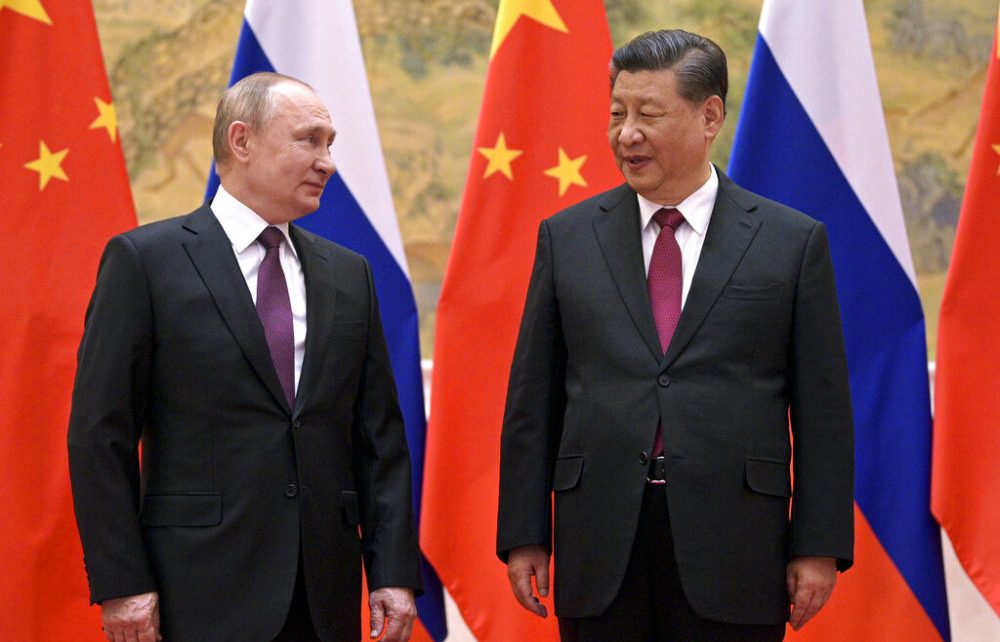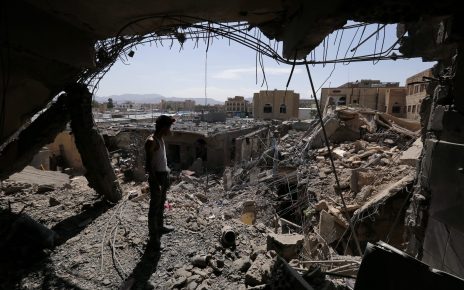Beijing’s Belt and Road Initiative has catapulted China into the position of a worldwide superpower, since its inception. Whilst Washington has for years scrambled to find an answer, how has the Ukraine war affected the ability of the US and its allies to combat China’s rising power?
Since February 24, 2022, when Russia declared its ‘special military operation’ and invaded Ukraine, the East-West divide has grown to 20th century Cold War heights. The capitalist West, represented by the US government and its allies, again fights a common enemy in China and Russia, however, this time, they also fight fellow capitalists. This New Cold War, as it is being called, has initiated some of the more predictable censorship and xenophobic coverage of the West’s enemy, which all of Russia has been declared and soon to be the Chinese people as well. This is a dangerous new reality, in which heavily armed nuclear powers again take each other to the brink, but one which has also paved the way to a new economic reality on the global chessboard.
When the war between Russia and Ukraine began, it quickly became apparent that this was no localized conflict, but instead an international proxy conflict. Whose side a country took would determine solidly the types of relationships they could hope to foster, and for the West, in theory, no country could remain neutral. Understanding this war as the West’s proxy war with Russia is the necessary starting point in order to understand the surrounding issues — which is why mentioning this could land you on kill lists and designate you an enemy agent, for simply offering a balanced analysis.
Where China Fits In
In 2013, China’s Belt and Road Initiative (BRI) was born, ostensibly seeking to build connectivity and cooperation on a global scale. Beijing has since then signed over 170 agreements, with more than 125 different countries, investing over a trillion dollars in a multitude of projects internationally. Despite encountering a number roadblocks along the way, and the dishonest framing of the BRI as being plagued with failures and veering on collapse, it has been phenomenally successful and landed Beijing a position that now contends with that of the United States.
During the Obama administration years, a number of steps were taken to begin countering expanding Chinese influence, including the introduction of the infamous Trans-Pacific Trade Partnership (TPP), in 2016, which was planned to be used as a tool for containing Chinese trade. However, the TPP was never ratified, and when Donald Trump took office he withdrew from the domestically unpopular partnership in 2017. As is well known, US President Donald Trump began harsh posturing against China, initiating what he called a trade war. His administration also disseminated hardcore propaganda against Beijing, included in which were racial epithets. The CIA front, known as the National Endowment for Democracy (NED), also invested in causing chaos in Hong Kong and encouraging separatist movements there.
Under the US Biden administration, the latest line of counter-BRI initiatives began with the Build Back Better World initiative, which was set to re-invent the nature of the US’ global empire and counter China’s Belt and Road initiative. However, Build Back Better was a massive failure domestically and did not gain approval from congress in 2021, despite hardcore lobbying efforts. Instead, US President Joe Biden set forth the Partnership for Global Infrastructure and Investment (PGII) in 2022, which brought together a block of seven Western allies to pursue the counter-BRI initiative. Along with this, also in 2022, the Indo-Pacific Economic Framework for Prosperity (IPEF) was also set forth, this initiative being tailored at increasing US power in what is considered to be China’s backyard, as a counter to Chinese influence.
The PGII, being the continuation of the Build Back Better World initiative, can been seen to have taken its original wording from the infamous slogan of the World Economic Forum (WEF), which popularized “build back better” in 2020. Part of that very model, to “build back better”, was to “reinvent capitalism“, according to the WEF. The WEF discourse surrounding the idea of reinventing capitalism, emerged on the global stage primarily as the result of a push from WEF executive chairman, Klaus Schwab, who advocates for stakeholder capitalism, the subject on which the World Economic Forum has focused its white papers since 2020. The idea of stakeholder capitalism is, in essence, to make the mega-corporations active outside the territory of their businesses and instead focused on shaping society.
If one is to read what is written by the adherents to this ideology, of pursuing stakeholder capitalism, it becomes clear that the ultimate goal is to empower the corporations and let them serve as the major deciders in world affairs. The reason this is relevant to point out, is because this is clearly the direction in which the West’s power is heading, and the excuse for implementing this transformative capitalist ruling system was largely the economic impacts inflicted during the Covid-era. This is to say that the power of the West is not necessarily just the power of countries, but the power of Western corporations, which will play a role in ongoing international disputes and further shape Western decision making. This is the plan at least.
Can The US Take On China’s Belt And Road Initiative?
Both the IPEF and PGII were launched following Russia’s invasion of Ukraine. This means that these strategies were started after the West’s sanctions on Moscow, in addition to the Western proxy war effort in Eastern Ukraine. These two initiatives were created to fit around the emerging multi-polar world. They were over 10 years in the making and were aimed, seemingly against Russia, but tailor made to combat China. A major problem the US is facing, however, is that Beijing has already invested more money into its Belt and Road initiative than the US’ PGII partner States set out to initially spend. On top of this, the BRI has already gained massive traction inside its target regions.
Some have pointed out that China’s investments in using Russia as a trade route to Europe have failed, which is true, for now, due to the ongoing conflict in Ukraine. However, another opportunity emerged in the wake of this, to develop the ‘Middle Corridor’ trade route; which entails using Kazakhstan, the Caspian Sea, Azerbaijan, and then Turkey as a trade route to Europe. Over the past months, China has been busy investing in Kazakhstan’s rail infrastructure, in order to make this option more viable. Although the US and its Western allies have attempted to counterbalance these developments with their own investments, Astana is solidly in both China’s, and even more so Russia’s, spheres of influence. As for Turkey, it, despite being part of NATO, is clearly in favor of the benefits of the Middle Corridor’s success and have strategically maintained a relationship with all sides; China, Russia and the US. Azerbaijan is in Turkey’s sphere of influence, meaning that the US government causing problems there could result in a number of issues.
As a strategic threat to the US’ number one foe in the Middle East, the Islamic Republic of Iran, it makes sense for Baku to be utilized against Tehran. Israel is also the current top exporter of weapons to Azerbaijan, while Baku supplies the majority of Tel Aviv’s energy supply. Although Israel certainly hopes to try and encourage further tensions between Iran and Azerbaijan, this could come at the cost of their cheap energy and their relations with Ankara. Israel therefore has to be calculating if it is to work with the United States, in creating turmoil between Azerbaijan and Iran. This is all to say, that sabotaging the Middle Corridor would have various unneeded consequences for all parties involved and is a difficult task for the US to pull off.
Another issue for the West is that the US dollar is slowly falling as the world reserve currency. In addition to this, on the diplomatic level, China has stepped in and brokered a historic normalization deal between historic regional foes, Saudi Arabia and Iran. The Middle East is considered by Washington to be part of its backyard, yet China has begun to take that throne, as Tehran and Moscow advance ties further. Throughout the world, from the likes of Algeria in Northern Africa, to Brazil in South America, the US has lost its grip on multiple regions and cannot depend upon them to follow them. BRICS — or the alliance started by Brazil, Russia, India, China, and South Africa that is acting as a counterbalance to Western economic hegemony — is now working on the development of a new common currency.
The war in Ukraine, or rather the West’s response to the war, has ushered in a new era in international politics, one that both sides have clearly prepared for and is now creating dramatic changes to the “New World Order” that was created after the Cold War. In order to preserve this new world order, where the US’ empire reigns supreme, the West needs to change the nature of its economic model and that is what it is currently doing. The US has now replaced Russia as Europe’s top supplier of Crude Oil, it has also along the way sacrificed Europe on the alter of the Ukraine war. The big question now, is whether China and the bloc of non-Western powers, including the likes of Russia, will prevail and defeat Washington, or will it be the West’s renewed strategy of handing the power to the corporations that could work to combat the growth of China?
The Direction of the West
Currently, throughout the Western world, there is a battle being waged on a cultural level, with all politics being reduced to what is understood to be a “Left vs Right” struggle. In reality, this is a culture war of identity politics and has little to do with any of the elements that could be pegged to traditional Left-Right politics. On one side, corporations promote the struggle of what has become the Democratic Party’s identity politics (so that of anyone who is not a straight-White-male) versus the Republican Party’s identity politics (which are the identity politics of straight-White-men). This has created a rise of far-right figures and movements, not only in the US, but throughout the West, encouraging an ultra-nationalist Right to emerge on this movement’s back. On the Left side of the spectrum there are a number of isolated groups, most constantly engaged in arguments over identity issues, of which the majority are not based in Marxian economics, anti-imperialism, or the direction of the working class in general, and this has for now destroyed any sort of class-based Leftist movements from entering the mainstream.
When the economy fails and people are struggling to pay rent, find money for the next meal, and seek the will to continue, it is an intelligent strategy to foster a fake enemy for the masses to fight against, in order to promote ultra-nationalism and revive a nation’s productivity. The fake enemy is the so-called “Left”, which is just a combination of identity politics espoused by a vast number of isolated and largely powerless minority groups. In order to make these minority group agendas seem powerful, or at least their supporters, the mega-corporations invest massively into what we now refer to as “Cancel Culture”. In reality, it is not trans people, gay people, black people, Muslims, or any other minority groups, that pose the threat, it is the government and its surrounding corporate oligarchy that has caused the misery and hopelessness faced today.
It is a fact that the majority of what constitutes the working class in most Western nations, statistically happens to be comprised of white people, a group that used to be economically privileged en-mass, when compared to the rest of the world. The white working class are now facing the results of failures by their government and corporate elitists, and are entering an era of hopelessness that has not hit them in this way for generations. It is this group that is being targeted to be harnessed as foot-soldiers for the new West. In order to have them comply, given how badly their living conditions have deteriorated, you must direct their anger elsewhere than where the power lingers. This means feeding these people propaganda, in order to make them rage against minority communities and the disenfranchised and to galvanize this group in order to carry out the whims of their corporate leaders. Just as hatred is a tool that is used to justify wars abroad, it is also a tool that can be used domestically too. Whether this agenda will play out, in the way that billionaire backed right-wing groups hope it will, may also play a factor in what happens next on the international stage as well.
This final piece of analysis is something that can be observed in the West’s current predicament but is solely based upon my own interpretation, as with the above segments of this article. I understand that this argument may sound somewhat conspiratorial and is not something I can prove with absolute certainty, but nonetheless I believe it to be an important concept for those reading to consider going forward.





